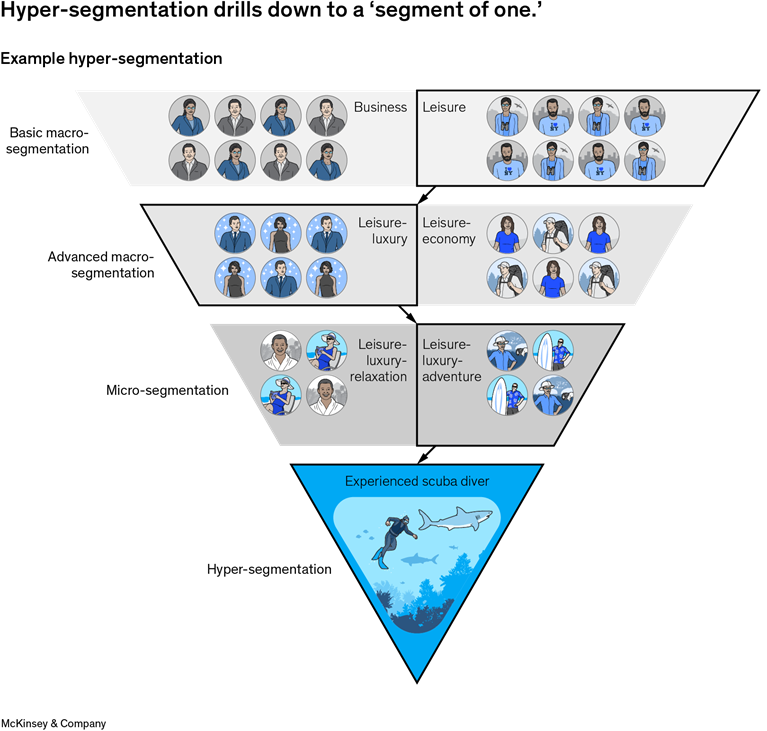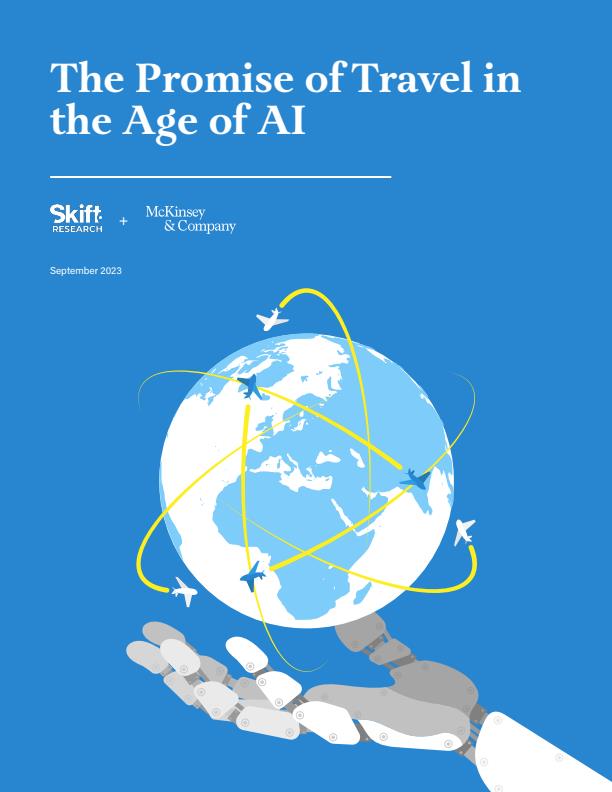Every generation has its own “golden age” of travel, often defined by the widespread adoption of new technology—from the jet engine of the 1950s that drastically reduced travel times to the dot-com period of the 1990s that allowed customers to build their dream itineraries online. Today, a new era of digitally enabled travel is upon us. Advances in artificial intelligence (AI), including generative AI (gen AI), and machine learning (ML) are equipping the industry to reimagine what it means to plan, book, and experience travel. This surge of innovation sets the stage for travel companies to rethink how they interact with customers, develop products and services, and manage operations.
Advances in technology have also transformed consumers’ expectations. Since 2013, time spent on digital devices has grown by 70 percent, and this trend only accelerated during the COVID-19 pandemic as online interactions increasingly replaced in-person contact.1 However, traditional travel is unique in that it is an inherently human-centric experience. The industry, therefore, has an opportunity—perhaps even a duty—to define what travel will look like in the digital age.
Most travel companies aim to provide exceptional service and deliver the perfect trip. But, instead of ease, excitement, and delight, travel operators too often fall short of meeting baseline expectations of timing and quality. In fact, nearly 80 percent of American travelers experienced at least one travel-related problem in the first half of 2023.2
In the 2021 report, Rebooting customer experience to bring back the magic of travel, McKinsey and Skift Research found that leisure travelers were eager to get back to the sky, water, and road—so much so, that they were often willing to overlook customer-service issues and inconveniences. Customer satisfaction ratings at the time were high, even in a period of intense disruption when negative sentiment was on the rise.3
Today, that window of acceptance may have passed. Customer expectations are rising, and tolerance is wearing thin. Despite this, people still aspire to travel and, according to McKinsey’s ConsumerWise Sentiment Survey, nearly a third of consumers intend to “splurge” on travel expenses in the next three months.4 Through both established and new technologies, companies have the opportunity to keep the aspiration to travel alive by closing the persistent gap between the promise and reality of travel.
While larger companies may have more resources to develop in-house capabilities, a robust ecosystem of service providers makes new technologies accessible to companies of all sizes. According to McKinsey Digital estimates, companies that holistically address digital and analytics opportunities throughout their organizations have the potential to see a 15 to 25 percent earnings improvement.
A new report, The promise of travel in the age of AI, produced by McKinsey and Skift Research offers use cases and success stories that detail how technologies are being used, drawing from interviews with executives at 17 companies across five types of travel business. It explores how companies apply advanced data science to better understand and serve customers, delves into how digital and analytics tools can improve products and services, and examines how new technologies augment workforce capabilities and unlock operational capacity. This article highlights some key findings.
Know your customers like you know your friends
Over the past two decades, the variety and volume of customer data that travel companies can capture has increased dramatically; new tools and technologies such as AI-powered assistants are only accelerating this trend. However, this data is often difficult to process and does not always paint a full picture of the customer. Companies may turn to third-party sources to complete their understanding—combining and distilling commercial, operational, financial, and behavioral inputs. Robust marketing technologies can then help distinguish the “signal” from the “noise” in the data to better predict customer behavior.
Having gained a clear and comprehensive understanding, companies can create customer segments to guide how they interact with and serve different customers. Depending on the data available and the analytics capabilities at hand, segmentation can range from grouping customers into segments based on a single macro characteristic (e.g., business versus leisure) to individual “segments of one,” known as hyper-segmentation.

Drilling down to segments of one can enable hyper-personalization, which is broadly defined as the ability to uniquely tailor touchpoints to an individual customer’s needs, preferences, and behaviors. At its core, hyper-personalization is not only about increasing conversion rates, but about providing the customer with an end-to-end experience adapted to their specific context. Considering the level of personalization that is becoming the norm in many aspects of daily life, companies are adopting an ongoing test-and-learn approach to ensure their offers and actions resonate with customers’ rising expectations.
Hyper-personalization can also help companies rebuild trust if operations have gone wrong. Personalized communication reassures customers that they are at the forefront of the company’s mind and instills confidence that a thoughtful recovery plan is in place. For example, companies may share real-time status updates in moments of disruption and provide tailored solutions, or even proactive compensation, to ensure customers feel individually taken care of.
Design your products to surprise and delight
Recent advances are pushing the boundaries of what technology can accomplish. Nothing illustrates this better than the meteoric rise of AI platforms like ChatGPT which garnered one million users in only five days.5 While this pace of adoption may feel unsettling, it provides an impetus for companies to reimagine their product design and delivery using AI and digitization.
Historically, capabilities such as language, creativity, and aesthetic judgment—once considered uniquely human—could not be scaled through technology. AI, particularly gen AI, offers a new way to augment and scale these capabilities with the potential for enormous benefits: according to McKinsey research, generative AI has the potential to unlock between $2 trillion and $4 trillion in annual value across industries.6 In the travel context, gen AI could take the form of a digital assistant that interacts with customers throughout the journey. It can provide personalized trip itineraries during discovery and booking, offer tailored recommendations based on preferences and real-time constraints during the trip, and help resolve unexpected disruptions.
However, AI is only part of the answer. Established digital technology also helps companies deliver on commitments made to customers. Many of these digital assets and tools rely on common systems and capabilities, making them widely attainable—freeing up staff to provide better face-to-face services and build relationships through the human touch. Several such applications can boost guest satisfaction and reduce points of friction in hotels, including guest apps, digital check-ins, digital room keys, and in-room tech. The magnitude of these individual tools is amplified when seamlessly integrated together, making it easier for customers to use digital applications throughout their hotel stay.
Empower your workforce to follow through on promises made
An engaged and productive workforce enables the delivery of experiences and products that satisfy customers. However, the travel industry faces structural labor hurdles and high turnover which makes attracting, training, and retaining top talent challenging. Fortunately, the industry can enhance and scale the capacity of its existing workforce by equipping the frontline with the right tools at the right time. This can free up employees to focus on the things they enjoy most and that make the travel industry tick: quality personal interactions with customers, in essence, the human touch.
Two promising opportunities to improve workforce and operational performance through technology stand out across the travel industry: augmenting frontline capacity and upskilling talent.
In the travel industry today, complex decisions still rely on human expertise and outdated technology such as greenscreen or rudimentary interfaces. This leads to a best-guess approach, the risk of negative outcomes, and a steep learning curve. Travel companies are developing new tools for the frontline to process complex inputs and help guide “day-of” decision making. For example, advanced simulation models such as digital twins allow companies to conduct rapid “what-if” analyses and provide real-time guidance to the frontline.
According to McKinsey research, new technology, including gen AI, is also shortening training times for new hires while rapidly upskilling the existing workforce. For instance, virtual and augmented reality are used to simulate real-life scenarios to prepare frontline employees to hit the ground running, and gen-AI-enabled "teaching assistants” provide personalized coaching based on individual performance.7
Travel is ripe for innovation
We believe this is a moment of optimism for the industry. Between reclaiming its historical share of GDP, benefiting from the ongoing corporate travel recovery, and catering to consumer demand for unique experiences, the stage is set for travel’s accelerated growth. Looking ahead, travel is forecasted to grow at an average of 5.8 percent a year through 2032—more than double the expected growth rate of the overall economy (at 2.7 percent a year).8
This does not mean that travel companies can simply sit back and reap the benefits. Existing and new technologies provide an avenue for companies to capture their share of the industry’s anticipated growth by resetting how they interact with customers, deliver products and services, and empower their workforce. Fortunately, there are a growing number of ways—build, buy, or partner—to help companies get started. The only wrong move is no move.



